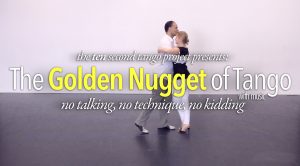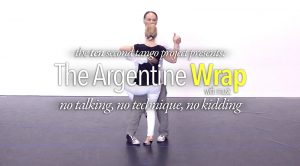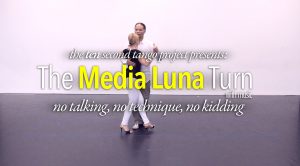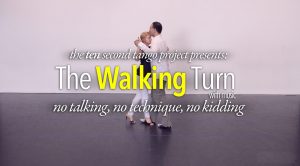The 10 Second Tango Project
The ‘10 Second’ Tango Project was a video series that shows 10 seconds of Tango Vocabulary. Because it usually only takes 10s to do it. However, I wanted to show how it applied to a metronome, as well as to a piece of music. There’s just one catch to the video series > There’s No Talking, No Discussion, No Explanations! Just the ‘moves.

The Mirror Cross
The Mirror Cross is a variation on an Argentine Cross theme. Meaning that there are a lot of types of Argentine Crosses. Two Hundred and Fifty-Six of them to be precise. One variation on that of the Mirror Cross. The reason it’s called a mirror cross is because it is a mirror image of the normal Argentine Cross that you’re more than likely familiar with.

The Dark Side Salida
The Dark Side Salida is a variation on a Salida theme. Meaning that there are a lot of types of Salidas. Lots of them. One variation on that idea of a Salida step, is the Dark Side. Which means that instead of starting on the open side of the embrace, you start the step on the closed side of the embrace, hence the ‘dark side’ moniker.

The Golden Nugget
The Golden Nugget of Tango is a Tango Topics construct (Hat tip to Daniel Trenner). You won’t find this in any other dance studio, or Tango Class. What’s the Golden Nugget ? Its every foundational move you’ll ever need to dance tango, milonga, or vals…

The Circular Ocho Cortado
The Circular Ocho Cortado is the quintessential variation of the Ocho Cortado, it is the one Cortado that actually looks like or resembles the idea of the literal translation of the word, Cortado > "Cut(ted)" Ocho. However, in this version of the Cut Ocho, the Follower is led to a Forward step, which almost NEVER happens in Ochos.

The Argentine Wrap
The Argentine Wrap or Enganche is one of 10 possible types of Wraps in Argentine Tango. To learn more, go here > https://tangotopics.com/argentine-wraps/

The Parada Back Cross
The Parada Back Cross is not a normal thing. Truth be told, it’s a variation reality with a twist, several actually. Ok, we made it up! It’s a fun toy that can be added to anyone’s dance. Yes, it’s a Parada, but the Back Cross doesn’t happen until after the Parada has completed itself. 🙂 There is one little tiny gotcha with this thing, and it’s the back cross itself.

The Super Enrosque
The Super Enrosque is one possible variation in what commonly referred to as "Lead Flash" with regards to Argentine Tango. Meaning that until you have mastered your walk, meaning that you are not pulling, or pushing, or compressing the living daylights of your Followers (tsk, tsk, tsk). Until you have mastered invoking Disassociation, and then Applied Disassociation, both of which are shown here.

The Media Luna Turn
The Media Luna Turn is one of Eight Types of Turns in Argentine Tango. Unfortunately, this turn isn’t used all that often for a variety of reasons, most notably is the fact that it’s not taught all that often. However, once it’s learned, it can and does become the staple of someone’s dance. https://tangotopics.com/argentine-media-luna/

Walking Turns
The Walking Turn is one of Eight Types of Turns in Argentine Tango. Unfortunately, this turn doesn’t get talked about all that often for one reason, that IF and WHEN it’s used, it has two built-in problems: 1.) For a single step or two, it can break the LINE of dance. 2.) During the walking turn phase, the turn can go ‘wide’, thereby breaking the LANE of one’s dance.
